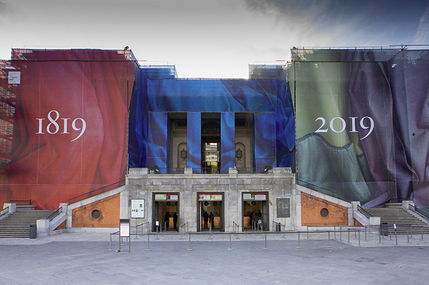Museo del Prado
The Museo del Prado opened to the public on 19 November 1819 as a Royal Museum of Painting and Sculpture. In 2019, we celebrated our Bicentenary, a commemoration that will reveal the path covered since 1819 until today. On this special occasion, we wanted to reflect on the future and the forthcoming challenges for this and the other great Museums of ancient painting: the need to attract social groups that traditionally are not attracted by the collections, to encourage gender and minority research studies or the challenges caused by overcrowding. Furthermore, for the following years the finalization of the Prado Campus is expected, adding the last building, the Hall of Realms, the old Buen Retiro Palace, an incorporation that will imply a rethinking of the current display of the collections. The activity plan for the bicentenary reinforces the usual programme of the Museo del Prado, insisting on the above mentioned aspects. The building that today houses the Museo Nacional del Prado was designed by architect Juan de Villanueva in 1785. It was constructed to house the Natural History Cabinet, by orders of King Charles III. However, the building's final purpose - as the new Royal Museum of Paintings and Sculptures - was the decision of the monarch's grandson, King Ferdinand VII, encouraged by his wife Queen Maria Isabel de Braganza.The Royal Museum, soon quickly renamed the National Museum of Paintings and Sculptures and subsequently the Museo Nacional del Prado, opened to the public for the first time in November 1819.
Access preferences
- Audio descriptions (Multisensory Experiences)
Coinciding with the presentation of “Touching the Prado”, the Museum has launched a new audioguide service that includes audio descriptions of 53 works in its collection.
These detailed explanations of the figures, themes and other elements depicted in the works are specifically aimed at visually impaired visitors. Fourteen descriptions of masterpieces in the collection are particularly detailed.
Audio descriptions are available free for visually impaired visitors at the Audioguide desks.
- Content accessibility (Easy Read & Understanding)
Personalised attention in Spanish sign language in visitor reception services, a magnetic loop in the Auditorium, signguides, audioguides with magnetic loop and the recently introduced audio descriptions, accessible website, and more
- Multimedia (Virtual Content)
In Spanish
- Physical accessibility (Accessible entrance for pushchairs and wheelchairs)
The Museum has remodelled its spaces in order to eliminate architectural barriers for physically impaired visitors, with the exception of some connecting zones in the Villanueva Building where specific architectural factors make this difficult. Various different solutions are currently being considered.
Wheelchairs and walking sticks available for visitors’ use.
- The Prado for All programme (Complementary Offer)
This programme aims to facilitate access to knowledge and culture for people with specific learning and communication needs. It takes place within inclusive environments that promote concepts such as participation, collaboration, autonomy, dialogue and diversity of abilities.
- Touching the Prado (Multisensory Experiences)
The Museo del Prado has launched its first initiative focused on visually impaired visitors and based on innovation and technology. As a result of this project, six works representative of different pictorial genres to be found in the Museum’s collections can now be touched.Developed in collaboration with professionals in the sector of visual impairment, this project allows for the reality of the painting to be perceived in order to mentally recreate it as a whole and thus provide an emotional perception of the work. Non-sighted visitors will be able to obtain a heightened degree of artistic-aesthetic-creative enjoyment in order to explain, discuss and analyse these works in the Prado.In addition to the three-dimensional images, the display will include didactic material such as texts in braille, audioguides and opaque glasses aimed at facilitating the experience for fully sighted visitors.
Contact info
Museo del Prado,
C. de Ruiz de Alarcón, 23,
28014 Madrid, Spain.
+34 913 30 28 00
cav@museodelprado.es
https://www.museodelprado.es/en